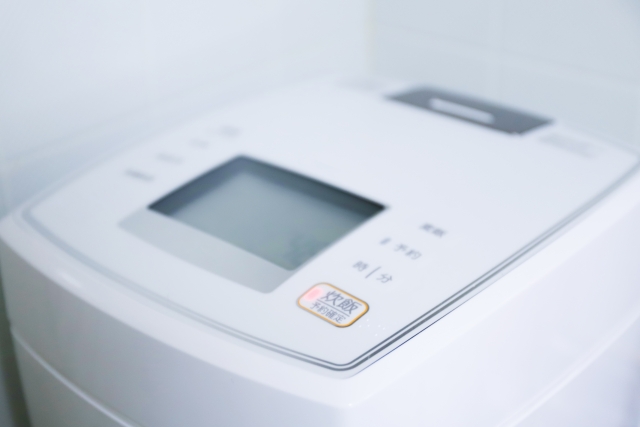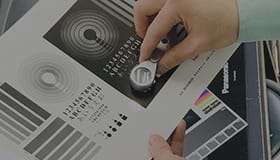Product overview
WIS Ink is two-pack screen ink for IMD/FIM that has a wide range of adhesion to easy adhesion treated PET, etc. Combined with IMB binder, it has excellent heat resistance and adhesion to molded resins during post-processing such as heat press molding and insert molding. It also has excellent re-solubility and is suitable for high speed printing.
- Solvent type ink

Application
- Home appliance nameplates, automobile nameplates
-
Automobile, Motorcycle
-
Home Appliance (IoT)
-
Smartphone, Tablet, Smart watch
-
Sensor
-
Game
-
Others
Features, Function
- Suitable for film insert molding with injection resin (PMMA, Acrylic), AS, ABS, PC/ABS, PC, etc., by combining with IMB Binder.
- No yellowing due to heat at injection molding, forming an ink layer with excellent heat resistance.
- Excellent re-solubility and is suitable for high-speed printing by cylinder printers.
- Non-silicon type ink
- Forming, workability
- Multi color setting
- High speed printing
- Fast dry, slow dry
Substrate
- Easy adhesion treated PET film
- Easy adhesion treated PET
Dilution
- G-002 SOLVENT(fast) G-003 SOLVENT(standard)
- Dilution 10 to 20%
- *Do not use other solvents as they may adversely affect curing, adhesion, stencil stability, or other properties.
Catalyst, Promoter mixing
- 101 Catalyst 10% (standard)
- Pot life: 7 to 8 hrs.
- *The ink will turn to gel after the pot life has expired. Be sure to mix only enough to use
Promoter
- SM-257 DEFOAMER 0.5% to 1.0%(For anti-foam and improvement in leveling)
Recommended cleaner
- Screen Cleaner L2
Mesh
- T 200 to 270 mesh(Coverage is 30 to 50m2/kg at 250 mesh)
Drying
- 80℃ 30 min
- Overprint
Each layer 80℃ 10 min(tack-free)
Final layer 80℃ 30 min
Standard colors
-
000 MEDIUM
-
001 VICTORIA
-
168 SCARLET
-
178 RED
-
182 RED
-
234 LIGHT YELLOW
-
277 OPAQUE REDDISH YELLOW
-
391 BLUE
-
581 VIOLET
-
611 WHITE
-
611 C OPAQUE WHITE
-
797 GREEN
-
821 VIOLET
-
911 BLACK
Caution
- Be sure to print a binder as an adhesive layer with the molding resin.
- When printing a binder, if the underlayer ink is excessively dry, peeling strength will be reduced. Be sure to print continuously up to the binder and conduct final drying.
- “IMB-003 BINDER” is recommended for general injection molding resins such as ABS, PMMA, etc. Please refer to the related product information sheet.
- In the forming process such as vacuum forming, pressure air forming, and mold forming, as well as in insert molding processes that integrate injection molded resin, a complex set of factors affect the performance of the final product, including the selection of printing materials and inks for design printing, printing conditions, printing sequence, drying method and conditions, selection of molding resin, mold design (gate shape, type and position, number of gates), and conditions set during injection molding.
- Preliminary testing under actual conditions is strongly recommended before a commercial run.
- Ink shelf life: 36 months from production date, unopened.
Safety
- UN No.: 1210
- UN Classification: Class 3 Flammable Liquids (Flash point is over 23 Degree C)
Handling
- Use safety gloves and eyeglasses to protect skin and eyes. If the ink comes in contact with skin, wash with soap and plenty of water (or lukewarm water) and consult with a doctor.
- Containers should be closed tightly after use and stored in a cool and dark place.
- SDS is available upon request. Please request a copy and read it carefully before handling the products.
Resistance
1. Printed materials
| Test item | Test Conditions | Test results |
|---|---|---|
| Adhesion | JIS K 5600-5-6:ISO2409(cross-cut),1mm interval 6×6, cellophane tape, peel off | 0 (no peel) |
| Pencil Hardness | JIS K 5600-5-4:ISO 15184(pencil), Weight 750g, Hardness of the pencil which does not make scar | H |
| Heat | JISK5600-6-3:ISO 3248, 80℃,200 hrs., check appearance and peel off from the substrate |
No defect |
| Humidity | JIS K 5600-7-2(Continuous condensation), 40℃, 95%RH, 240 hrs. Check appearance and peel off from the substrate |
No defect |
- Test conditions
【WIS-611 WHITE (2 layers)】 【101 Catalyst 10%】 【G-003 SOLVENT 20%】 【80℃ 10 min(interim)、80℃-30 min(final)】 【T 250】 【Substrate:0.188 mmTreated PET(Toray Lumirror U35)】
2.Molded materials
| Test item | Test Conditions | Test results |
|---|---|---|
| Heat | JIS K5600-6-3:ISO 3248, 80℃,200 hrs. check appearance and peel off from the substrate | No defect |
| Humidity | JIS K 5600-7-2(Continuous condensation), 65℃, 95%RH, 240 hrs. Check appearance and peel off |
No defect |
| Accelerated weathering(Xenon) | JIS K-5600-7-7:ISO 11341, BP Temp. 63±3℃ Raining rate 18 min/120 min, 600 hrs., check color fade and peel off | ⊿E<2 No peel |
- Above resistance test results are measured results in our laboratory and they are not guaranteed values.
- Information contained in this catalog may change without prior notice.
FAQ
-
What is the meaning of FIM/IMD?
-
The abbreviations, FIM and IMD, stand for Film Insert Molding and In-Mold Decoration. For these methods, the printed film is set into the mold and molded with molding resin as the finished product.
We recommend reading the FIM/IMD technology White Paper:
(1) FIM/IMD – 3 Process stages & Benefits
(2) FIM/IMD – Screen printing process –
(3) FIM/IMD – Forming process –
(Final) FIM/IMD – Injection process –We recommend reading the following reports:
Environmentally Friendly FIM/IMD Ink and Binder
IMB-HF006 Binder (Halogen Free, Environmentally Friendly Binder for IMD/FIM)
IPX-HF Screen Ink (2 Pack Halogen Free Environmentally Friendly Ink for IMD/FIM)
2 Pack Ink for FIM/IMD Applications
Adding High Value to Products with FIM/IMD (Part 3)
Adding High Value to Products with FIM/IMD (Part 2)
Adding High Value to Products with FIM/IMD (Part 1)
Teikoku Provides New Color and New Function to Plastic Products
FIM/IMD Technique: FIM Ink Design Technique,Optimization Technique of Forming Conditions -
Using FIM/IMD method, can you give us some examples of substrate film and molding resin combinations?
-
PC, PET, and Acrylic substrate sheets are suitable. Suitable resins are PC, PMMA, PC/ABS, AS, etc. However, PP and Olefin are currently difficult to use because they do not have good adhesiveness to the substrate materials.
-
What is the difference between Film Insert Molding and In Mold Decoration? Do you use different inks for each?
-
For the FIM method, the printed surface will be placed between the substrate sheet and the resin. On the other hand, for IMD method, the printed surface will appear on top of the adhered layer of the substrate sheet and the resin. The type ink will depend on the application and your requirements.
-
What is the largest size that you can use for the Insert Molding Method?
-
Theoretically, it depends on the capability of molding machine. However, there is an elongation limit of the substrate sheet; it varies depending on the printing materials you are using.
-
Can you give some examples of the type of industry where a combination of ink and molding method is being used? What would be the actual finished product?
-
The main industries will be automobile interiors, amusements, and home appliances. Their finished products are such items as speedometers, pinball game machines, water boilers, TVs and possibly as cover material in various other areas.
-
Do you have any restrictions when you use functional inks for molding inks?
-
There are some limitations of color hue, glossiness, and other properties. Sometimes, Teikoku Inks is unable to meet a customer’s requirements due to the design of the product.
-
We found that sometimes when we peel off the print from the injected resin, ink remains on one side or sometimes on both sides. Why does this occur?
-
In the case of ink remaining on the substrate, adhesion to the injected resin is poor. When ink remains on the injected resin, the adhesion to the substrate is poor. This is delamination. When ink remains on both sides, adhesion to substrate and injected resin are good, but the cohesion of the ink layer is poor. This is a cohesion failure.
-
The printed layer peeled away from the injected resin. What should we do?
-
This may be due to a mismatch of ink, substrate and the resin. Please contact our representative.
-
We have always had good adhesion, but suddenly peeling has occurred. What should we do?
-
Ink attached so far but it suddenly peeled off. I don’t know what to do.
Please check the following.
(1) Film thickness of printed ink layer
Thinner binder layer tends to have weaker adhesion.
(2) Drying conditions for printed ink layer
If ink doesn’t dry sufficiently, the strength of the printed ink layer becomes weak and cohesive fracture will occur.
(3) Are there any additives such as defoamer contained in ink or binder?
If additive such as defoamer is added in ink, ink’s adhesion to resin tends to be weak. -
What are the meanings of X and Q used in the ink names such as IPX, INQ, FMX, etc.?
-
X and Q are used to designate isophorone-free inks.
- Related technical information
-
- Technology lecture for FIM/IMD 1st session: Explanation of the merit and 3 process.
- Technology lecture for FIM/IMD 2nd session: Explanation of the screen printing process.
- Technology lecture for FIM/IMD 3rd session: Explanation of the Forming Process.
- Technology lecture for FIM/IMD Final session: Explanation of the Injection Process
- Related event information

